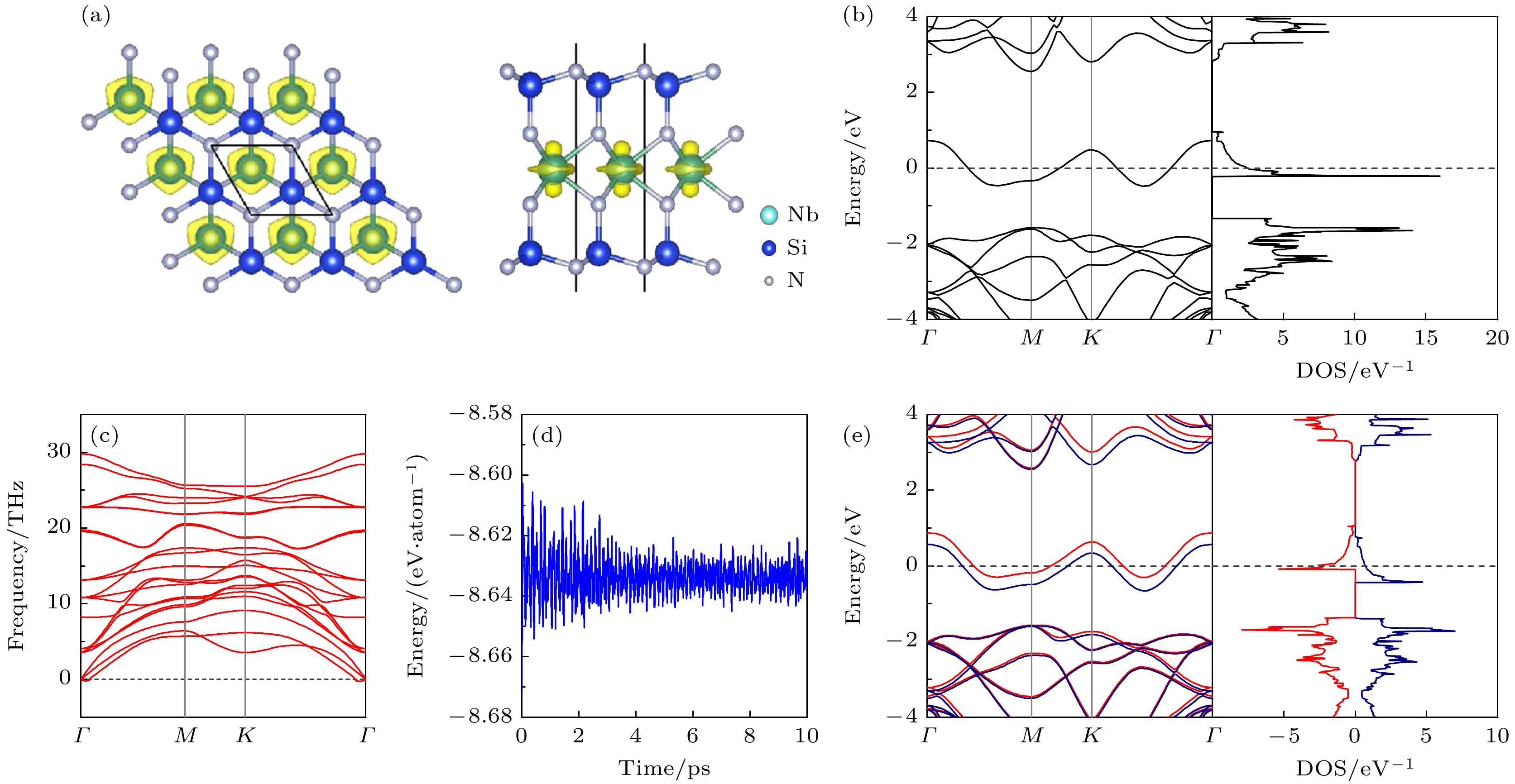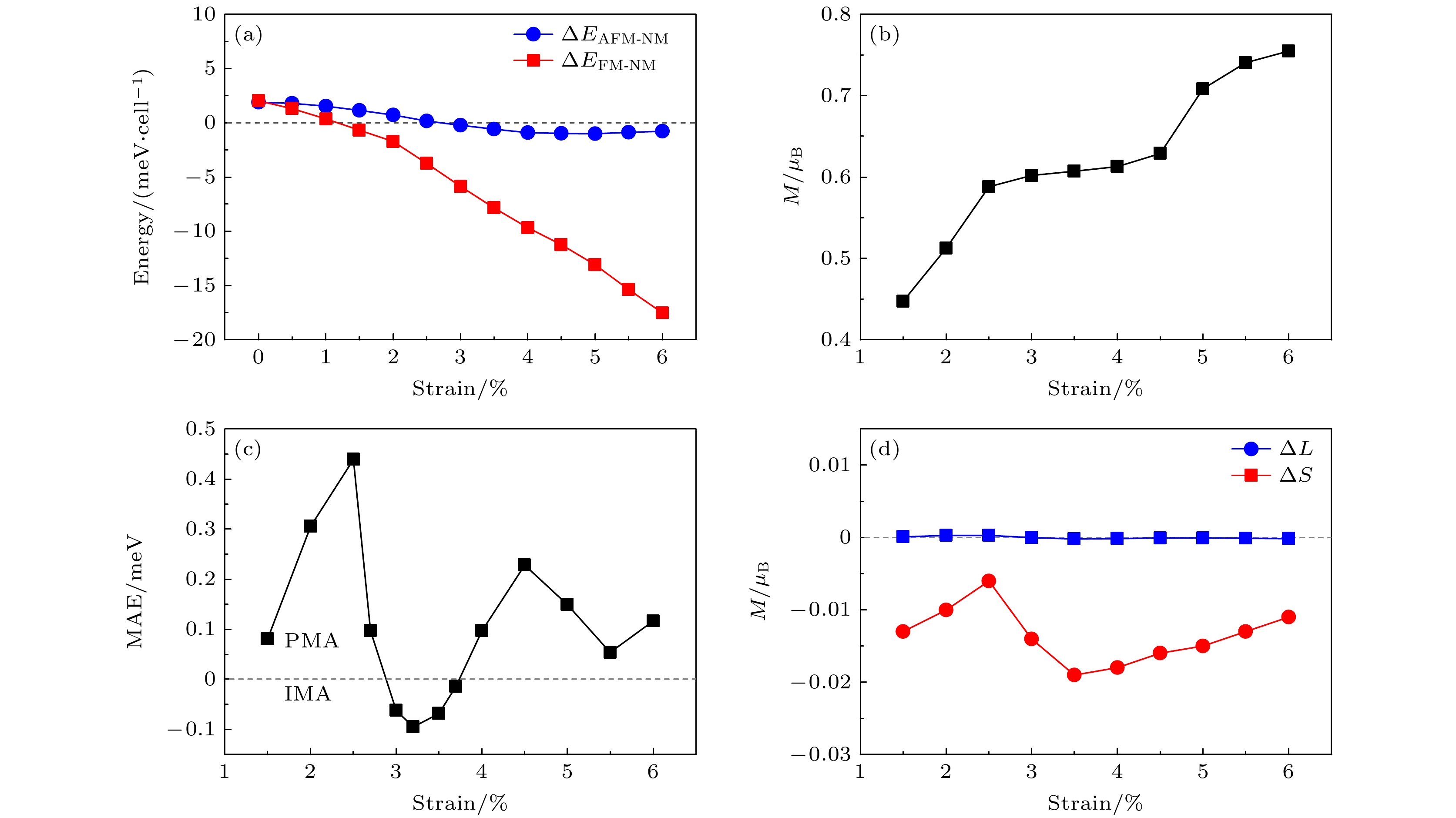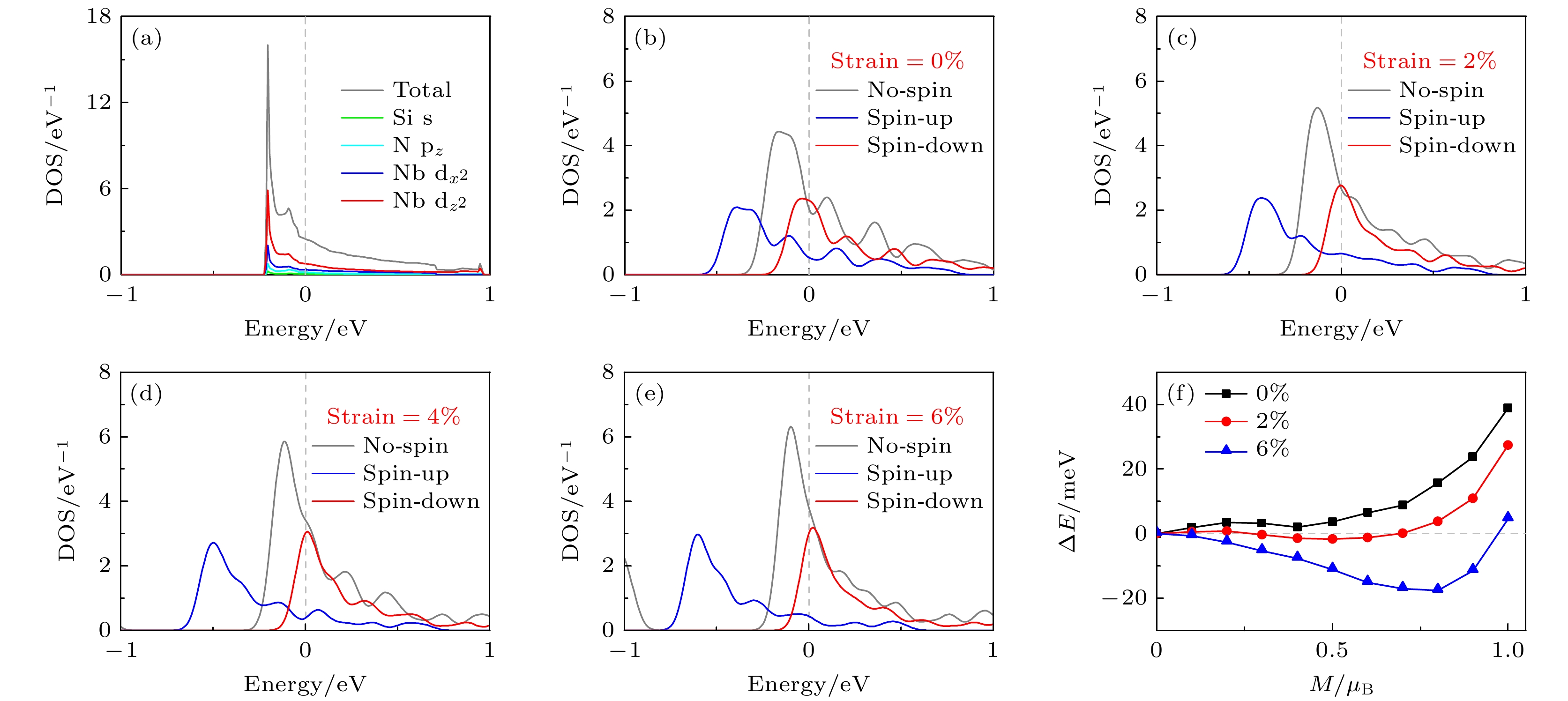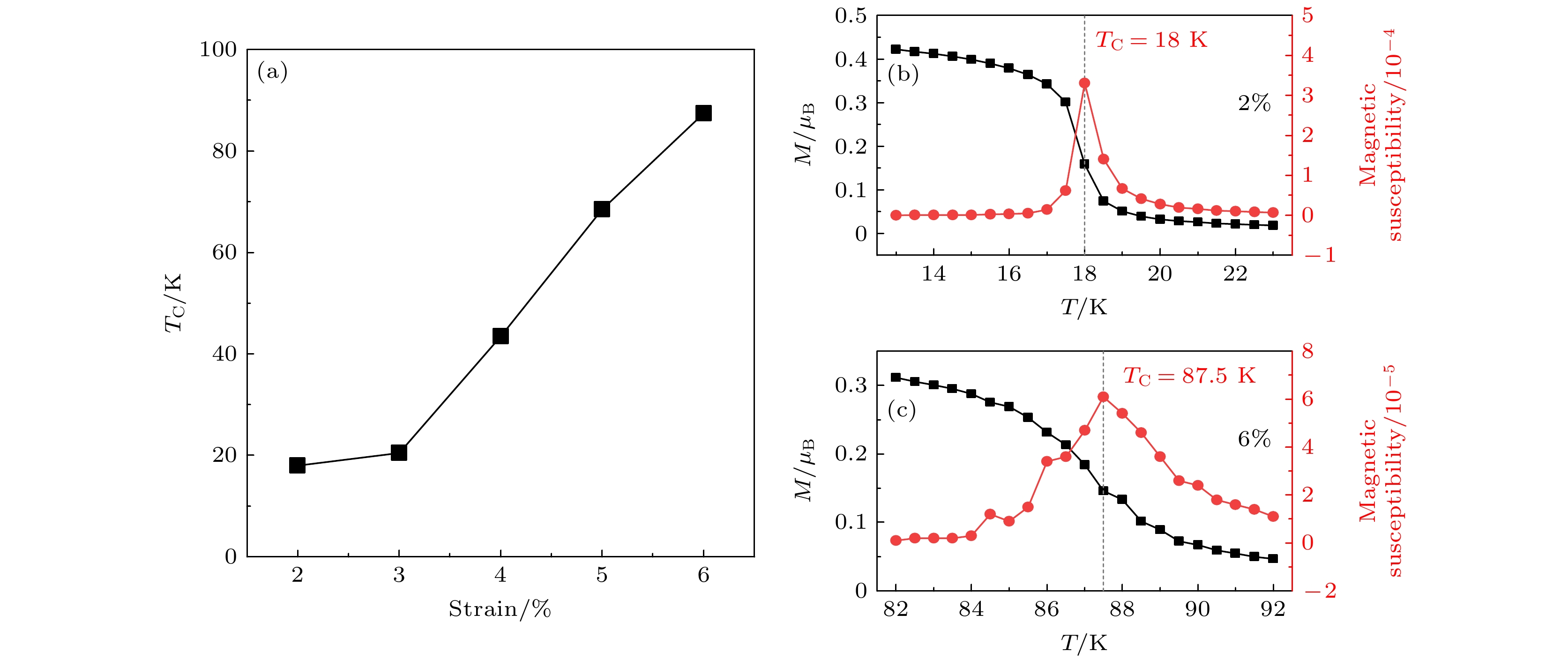-
二维材料磁性的有效调控属于国内外的前沿研究领域. 本文运用基于密度泛函理论的第一性原理方法, 研究了双轴拉伸应变对单层NbSi2N4磁性的影响. 声子谱和分子动力学的计算结果表明, 单层NbSi2N4结构具有良好的动力学与热力学稳定性. 研究发现单层NbSi2N4为无磁金属, 1.5%的双轴拉伸应变可使其转变为铁磁金属. 对单层NbSi2N4材料电子结构的分析表明, 拉伸应变诱导的铁磁性具有巡游电子起源: 当不考虑自旋极化时, 单层NbSi2N4在费米能级处存在一条半满的能带, 其主要由Nb原子的dz2轨道贡献, 拉伸应变可使其更局域化, 进而引起斯通纳不稳定性, 导致铁磁性的产生. 此外, 对磁各向异性能的计算表明, 应变可使单层NbSi2N4的易磁化轴方向发生垂直-面内-垂直方向的翻转. 基于海森伯模型的蒙特卡罗模拟结果表明, 拉伸应变可显著提高单层NbSi2N4的居里温度. 单层NbSi2N4的居里温度在2%应变时为18 K, 在6%应变时提高到87.5 K, 比2%应变时提高了386%. 本研究为应变调控二维层状材料的磁性提供了理论参考, 在力学传感器设计和低温磁制冷领域有着潜在的应用前景.The effective control of two-dimensional material magnetism is a frontier research field. In this work, the influences of in-plane biaxial tension strain on the electronic structure, magnetic properties, and Curie temperature of monolayer NbSi2N4 are investigated by first-principles calculations based on density functional theory and Monte Carlo simulations in the frame of the Heisenberg model. We demonstrate that the monolayer NbSi2N4 has favorable dynamic and thermal stability through the phonon spectral calculations and ab initio molecular dynamics simulations. It is found that the intrinsic monolayer NbSi2N4 is a non-magnetic metal, which can be transformed into a ferromagnetic metal by 1.5% tensile strain. The electronic structure analysis of monolayer NbSi2N4 shows that the ferromagnetism induced by tensile strain is caused by traveling electrons. There is a half-full band at the monolayer NbSi2N4 Fermi level, which is mainly contributed by the dz2 orbital of the Nb atom. When there is no additional strain, the band is spin-degenerate. Tensile strain can make this band more localized, which leads to Stoner instability, resulting in the ferromagnetic ordering of monolayer NbSi2N4 traveling electrons. The stability of the ferromagnetic coupling is enhanced with the increase of the strain degree. The calculation results of the magnetic anisotropy energy show that the strain can make the direction of the easy magnetization axis of the monolayer NbSi2N4 reverse from the vertical direction to the in-plane, and then back to the vertical direction. Furthermore, the strain can significantly increase the Curie temperature of monolayer NbSi2N4. The Curie temperature of monolayer NbSi2N4 is 18 K at 2% strain and 87.5 K at 6% strain, which is 386% higher than that at 2% strain. Strain engineering can effectively control the magnetic ground state and Curie temperature of single-layer NbSi2N4. The research results are expected to promote the development of MA2Z4 materials in the field of mechanical sensing device design and low-temperature magnetic refrigeration.
-
Keywords:
- two dimensional material /
- first-principle /
- magnetism /
- strain
[1] Jansen R 2012 Nat. Mater. 11 400
 Google Scholar
Google Scholar
[2] Lin X Y, Yang W, Wang K L, Zhao W S 2019 Nat. Electron. 2 274
 Google Scholar
Google Scholar
[3] Choudhuri I, Bhauriyal P, Pathak B 2019 Chem. Mater. 31 8260
 Google Scholar
Google Scholar
[4] Sun Y J, Zhuo Z W, Wu X J, Yang J L 2017 Nano Lett. 17 2771
 Google Scholar
Google Scholar
[5] Miao Y P, Huang Y H, Fang Q L, Yang Z, Xu K W, Ma F, Chu P K 2016 J. Mater. Sci. 51 9514
 Google Scholar
Google Scholar
[6] Kaloni T P 2014 J. Phys. Chem. C 118 25200
 Google Scholar
Google Scholar
[7] Mao Y L, Guo G, Yuan J M, Zhong J X 2019 Appl. Surf. Sci. 464 236
 Google Scholar
Google Scholar
[8] Eean F, Arkin H, Aktürk E 2017 RSC Adv. 7 37815
 Google Scholar
Google Scholar
[9] Huang B, Clark G, Navarro-Moratalla E, Klein D, Cheng R, Seyler K, Zhong D, Schmidgall E, McGuire M, Cobden D, Yao W, Xiao D, Jarillo-Herrero P, Xu X D 2017 Nature 546 270
 Google Scholar
Google Scholar
[10] Gong C, Li L, Li Z L, Ji H W, Stern A, Xia Y, Cao T, Bao W, Wang C Z, Wang Y, Qiu Z Q, Cava R J, Louie S G, Xia J, Zhang X 2017 Nature 546 265
 Google Scholar
Google Scholar
[11] Wang L, Shi Y P, Liu M F, et al. 2021 Nat. Commun. 12 2361
[12] Hong Y L, Liu Z, Wang L, Zhou T, Ma W, Xu C, Feng S, Chen L, Chen M L, Sun D M, Chen X Q, Cheng H M, Ren W 2020 Science 369 670
 Google Scholar
Google Scholar
[13] Novoselov K S 2020 Natl. Sci. Rev. 7 1842
 Google Scholar
Google Scholar
[14] Yang C, Song Z, Sun X, Lu J 2021 Phys. Rev. B 103 035308
 Google Scholar
Google Scholar
[15] Yang J S, Zhao L N, Li S Q, Liu H S, Wang L, Chen M D, Gao J F, Zhao J J 2021 Nanoscale 13 5479
 Google Scholar
Google Scholar
[16] Chen J, Tang Q 2021 Chem. Eur. J. 27 9925
 Google Scholar
Google Scholar
[17] Guo S D, Mu W Q, Zhu Y T, Chen X Q 2020 Phys. Chem. Chem. Phys. 22 28359
 Google Scholar
Google Scholar
[18] Li F, Ren Y L, Wan W H, Liu Y, Ge Y F 2021 AIP Advances 11 115220
 Google Scholar
Google Scholar
[19] Zheng F W, Zhao J Z, Liu Z, Li M L, Zhou M, Zhang S B, Zhang P 2018 Nanoscale 10 14298
 Google Scholar
Google Scholar
[20] Wu Z W, Yu J, Yuan S J 2019 Phys. Chem. Chem. Phys. 21 7750
 Google Scholar
Google Scholar
[21] Chen T, Liu G G, Dong X S, Li H L, Zhou G H 2022 J. Electron. Mater. 51 2212
 Google Scholar
Google Scholar
[22] Wu Z B, Shen Z, Xue Y F, Song C S 2022 Phys. Rev. Mater. 6 014011
 Google Scholar
Google Scholar
[23] Qin H F, Chen J, Sun B, Tang Y L, Ni Y X, Chen Z F, Wang H Y, Chen Y Z 2021 Phys. Chem. Chem. Phys. 23 22078
 Google Scholar
Google Scholar
[24] Liu L F, Hu X H, Wang Y F, Krasheninnikov A V, Chen Z F, Sun L T 2021 Nanotechnology 32 485408
 Google Scholar
Google Scholar
[25] Xie W Q, Lu Z W, He C C, Yang X B, Zhao Y J 2021 J. Phys. Condens. Matter 33 215803
 Google Scholar
Google Scholar
[26] Kresse G, Furthmüller J 1996 Comput. Mater. Sci. 6 15
 Google Scholar
Google Scholar
[27] Kresse G, Furthmüller J, Hafner J 1994 Phys. Rev. B 50 13181
 Google Scholar
Google Scholar
[28] Perdew J P, Burke K, Ernzerhof M 1996 Phys. Rev. Lett. 77 3865
 Google Scholar
Google Scholar
[29] Kresse G, Joubert D 1999 Phys. Rev. B 59 1758
[30] Monkhorst H J, Pack J D 1976 Phys. Rev. B 13 5188
 Google Scholar
Google Scholar
[31] Togo A, Oba F, Tanaka I 2008 Phys. Rev. B 78 134106
 Google Scholar
Google Scholar
[32] Joyce G 1967 Phys. Rev. 155 478
 Google Scholar
Google Scholar
[33] Liu L, Chen S S, Lin Z Z, Zhang X 2020 J. Phys. Chem. Lett. 11 7893
 Google Scholar
Google Scholar
[34] Duong D L, Burghard M, Schön J C 2015 Phys. Rev. B 92 245131
 Google Scholar
Google Scholar
[35] Van Vleck J H 1937 Phys. Rev. 52 1178
 Google Scholar
Google Scholar
[36] Sieberer M, Khmelevskyi S, Mohn P 2006 Phys. Rev. B 74 014416
 Google Scholar
Google Scholar
[37] Zhuang H L L, Kent P R C, Hennig R G 2016 Phys. Rev. B 93 134407
 Google Scholar
Google Scholar
[38] Kulish V V, Huang W 2017 J. Mater. Chem. C 5 8734
 Google Scholar
Google Scholar
[39] Zhao Y, Liu Q X, Xing J P, Jiang X, Zhao J J 2022 Nanoscale Adv. 4 600
 Google Scholar
Google Scholar
[40] Sun X Y, Yang K, Li Z Y 2022 Phys. Status Solidi RRL 16 2100611
 Google Scholar
Google Scholar
-
图 1 (a)单层NbSi2N4的俯视图(左)和侧视图(右), 自旋密度分布用黄色表示; (b)不考虑自旋极化时单层NbSi2N4的能带结构和态密度图; (c)单层NbSi2N4的声子谱图; (d)温度300 K, 时长10 ps的分子动力学模拟下, 系统总能量的变化; (e)考虑自旋极化时单层NbSi2N4的能带结构和态密度图
Fig. 1. (a) Top view (left) and side view (right) of monolayer NbSi2N4, and the spin density distribution is represented in yellow; (b) energy band structure and density of states of monolayer NbSi2N4 without considering spin polarization; (c) phonon spectra of monolayer NbSi2N4; (d) the change of total energy of the system under the molecular dynamics simulation of temperature 300 K and duration 10 ps; (e) energy band structure and density of states of monolayer NbSi2N4 considering spin polarization.
图 2 (a)单层NbSi2N4铁磁态与无磁态间的能量差随电子温度的变化关系; (b)单层NbSi2N4在2%应变下的声子谱; (c) 单层NbSi2N4 6%应变下的声子谱
Fig. 2. (a) Variation of energy difference between ferromagnetic and nonmagnetic states of monolayer NbSi2N4 with electron temperature; (b) the phonon spectrum of monolayer NbSi2N4 at 2% strain; (c) the phonon spectrum of monolayer NbSi2N4 at 6% strain.
图 3 (a) 单层NbSi2N4反铁磁态和铁磁态与无磁态间能量差随应变变化; (b)单层NbSi2N4磁矩随应变变化; (c) MAE随应变变化; (d)不同应变下, Nb原子轨道磁矩与自旋磁矩对MAE的贡献
Fig. 3. (a) Energy difference between antiferromagnetic state, ferromagnetic state and non-magnetic state of monolayer NbSi2N4 with strain; (b) magnetic moment of monolayer NbSi2N4 with strain; (c) MAE with strain; (d) contribution of orbital magnetic moment and spin magnetic moment of Nb atom to MAE under different strains.
图 4 (a) 单层NbSi2N4分波态密度; (b)—(e) 单层NbSi2N4在不同应变下的态密度; (f)铁磁态与无磁态间的能量差随磁矩变化的DFT计算曲线, 将无磁态的能量设为0 meV
Fig. 4. (a) Fractional density of states of monolayer NbSi2N4. (b)–(e) The density of state of monolayer NbSi2N4 under different strains. (f) DFT calculation curve of the energy difference between the FM state and the NM state change with the magnetic moment, the energy of the NM state is set to 0 meV.
表 1 在不同应变下的交换常数J和各向异性参数D
Table 1. Exchange constant J and anisotropy parameter D under different strains.
应变/% 2 3 4 5 6 J/meV –2.430 –5.625 –8.767 –12.109 –16.753 D/meV 1.224 –0.248 0.388 0.596 0.468 -
[1] Jansen R 2012 Nat. Mater. 11 400
 Google Scholar
Google Scholar
[2] Lin X Y, Yang W, Wang K L, Zhao W S 2019 Nat. Electron. 2 274
 Google Scholar
Google Scholar
[3] Choudhuri I, Bhauriyal P, Pathak B 2019 Chem. Mater. 31 8260
 Google Scholar
Google Scholar
[4] Sun Y J, Zhuo Z W, Wu X J, Yang J L 2017 Nano Lett. 17 2771
 Google Scholar
Google Scholar
[5] Miao Y P, Huang Y H, Fang Q L, Yang Z, Xu K W, Ma F, Chu P K 2016 J. Mater. Sci. 51 9514
 Google Scholar
Google Scholar
[6] Kaloni T P 2014 J. Phys. Chem. C 118 25200
 Google Scholar
Google Scholar
[7] Mao Y L, Guo G, Yuan J M, Zhong J X 2019 Appl. Surf. Sci. 464 236
 Google Scholar
Google Scholar
[8] Eean F, Arkin H, Aktürk E 2017 RSC Adv. 7 37815
 Google Scholar
Google Scholar
[9] Huang B, Clark G, Navarro-Moratalla E, Klein D, Cheng R, Seyler K, Zhong D, Schmidgall E, McGuire M, Cobden D, Yao W, Xiao D, Jarillo-Herrero P, Xu X D 2017 Nature 546 270
 Google Scholar
Google Scholar
[10] Gong C, Li L, Li Z L, Ji H W, Stern A, Xia Y, Cao T, Bao W, Wang C Z, Wang Y, Qiu Z Q, Cava R J, Louie S G, Xia J, Zhang X 2017 Nature 546 265
 Google Scholar
Google Scholar
[11] Wang L, Shi Y P, Liu M F, et al. 2021 Nat. Commun. 12 2361
[12] Hong Y L, Liu Z, Wang L, Zhou T, Ma W, Xu C, Feng S, Chen L, Chen M L, Sun D M, Chen X Q, Cheng H M, Ren W 2020 Science 369 670
 Google Scholar
Google Scholar
[13] Novoselov K S 2020 Natl. Sci. Rev. 7 1842
 Google Scholar
Google Scholar
[14] Yang C, Song Z, Sun X, Lu J 2021 Phys. Rev. B 103 035308
 Google Scholar
Google Scholar
[15] Yang J S, Zhao L N, Li S Q, Liu H S, Wang L, Chen M D, Gao J F, Zhao J J 2021 Nanoscale 13 5479
 Google Scholar
Google Scholar
[16] Chen J, Tang Q 2021 Chem. Eur. J. 27 9925
 Google Scholar
Google Scholar
[17] Guo S D, Mu W Q, Zhu Y T, Chen X Q 2020 Phys. Chem. Chem. Phys. 22 28359
 Google Scholar
Google Scholar
[18] Li F, Ren Y L, Wan W H, Liu Y, Ge Y F 2021 AIP Advances 11 115220
 Google Scholar
Google Scholar
[19] Zheng F W, Zhao J Z, Liu Z, Li M L, Zhou M, Zhang S B, Zhang P 2018 Nanoscale 10 14298
 Google Scholar
Google Scholar
[20] Wu Z W, Yu J, Yuan S J 2019 Phys. Chem. Chem. Phys. 21 7750
 Google Scholar
Google Scholar
[21] Chen T, Liu G G, Dong X S, Li H L, Zhou G H 2022 J. Electron. Mater. 51 2212
 Google Scholar
Google Scholar
[22] Wu Z B, Shen Z, Xue Y F, Song C S 2022 Phys. Rev. Mater. 6 014011
 Google Scholar
Google Scholar
[23] Qin H F, Chen J, Sun B, Tang Y L, Ni Y X, Chen Z F, Wang H Y, Chen Y Z 2021 Phys. Chem. Chem. Phys. 23 22078
 Google Scholar
Google Scholar
[24] Liu L F, Hu X H, Wang Y F, Krasheninnikov A V, Chen Z F, Sun L T 2021 Nanotechnology 32 485408
 Google Scholar
Google Scholar
[25] Xie W Q, Lu Z W, He C C, Yang X B, Zhao Y J 2021 J. Phys. Condens. Matter 33 215803
 Google Scholar
Google Scholar
[26] Kresse G, Furthmüller J 1996 Comput. Mater. Sci. 6 15
 Google Scholar
Google Scholar
[27] Kresse G, Furthmüller J, Hafner J 1994 Phys. Rev. B 50 13181
 Google Scholar
Google Scholar
[28] Perdew J P, Burke K, Ernzerhof M 1996 Phys. Rev. Lett. 77 3865
 Google Scholar
Google Scholar
[29] Kresse G, Joubert D 1999 Phys. Rev. B 59 1758
[30] Monkhorst H J, Pack J D 1976 Phys. Rev. B 13 5188
 Google Scholar
Google Scholar
[31] Togo A, Oba F, Tanaka I 2008 Phys. Rev. B 78 134106
 Google Scholar
Google Scholar
[32] Joyce G 1967 Phys. Rev. 155 478
 Google Scholar
Google Scholar
[33] Liu L, Chen S S, Lin Z Z, Zhang X 2020 J. Phys. Chem. Lett. 11 7893
 Google Scholar
Google Scholar
[34] Duong D L, Burghard M, Schön J C 2015 Phys. Rev. B 92 245131
 Google Scholar
Google Scholar
[35] Van Vleck J H 1937 Phys. Rev. 52 1178
 Google Scholar
Google Scholar
[36] Sieberer M, Khmelevskyi S, Mohn P 2006 Phys. Rev. B 74 014416
 Google Scholar
Google Scholar
[37] Zhuang H L L, Kent P R C, Hennig R G 2016 Phys. Rev. B 93 134407
 Google Scholar
Google Scholar
[38] Kulish V V, Huang W 2017 J. Mater. Chem. C 5 8734
 Google Scholar
Google Scholar
[39] Zhao Y, Liu Q X, Xing J P, Jiang X, Zhao J J 2022 Nanoscale Adv. 4 600
 Google Scholar
Google Scholar
[40] Sun X Y, Yang K, Li Z Y 2022 Phys. Status Solidi RRL 16 2100611
 Google Scholar
Google Scholar
计量
- 文章访问数: 9555
- PDF下载量: 255
- 被引次数: 0














 下载:
下载:




